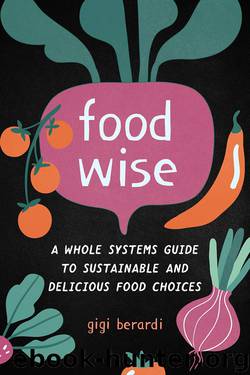FoodWISE by Gigi Berardi

Author:Gigi Berardi
Language: eng
Format: epub
ISBN: 9781623173920
Publisher: North Atlantic Books
Published: 2019-11-17T16:00:00+00:00
Carbohydrates and the Problem of Fructose
What about those carbs? Just as we did with fats, let’s start by seeing what exactly a carbohydrate is. Carbohydrates can be found as sugars but also in more complex forms. Sugars like glucose and fructose are known as “monosaccharides” or single sugars; sugars like sucrose (regular table sugar) or lactose (found in milk) are known as “disaccharides” or double sugars. Each sucrose molecule is composed of two single sugars—one glucose and one fructose. The third major category of carbohydrate (single and double sugars being the first two) is complex carbohydrates. These consist of more complex forms like starches and fiber typically found in vegetables like potatoes and corn (but also in whole and refined grains).
Just as with fats, cutting out carbs altogether isn’t a safe solution to whatever we think our dietary problems are. But we should be mindful of what kinds of carbs we consume. Enter Robert Lustig, whose work in pediatric neuroendocrinology centers around an ingredient you can probably find in almost every processed juice or condiment in your fridge—fructose. Sucrose or table sugar is in many of our foods, and, as I just mentioned, half of each sucrose molecule is fructose. We eat a lot of sugar, and that means we eat a lot of fructose. We also eat a lot of high fructose corn syrup (HFCS), a cheap sweetener that’s about 20% sweeter than white table sugar. According to Lustig, that sweetener may be the source of a lot of our health problems.
Estimates of past and present sugar consumption vary. Two hundred years ago Americans, on average, ate perhaps two to four pounds of added sugar a year. Now we eat, by one estimate, 17 teaspoons (about 71 grams) daily or about 57 pounds each year, or by another estimate about 152 pounds per year. Don’t worry about which estimate is more accurate—both are alarming. Recommendations from groups such as the World Health Organization are to reduce intake, for adults, to no more than one-third to one-half our current consumption.
Lustig’s research addresses many questions, one of which is: What happens to us when we consume fructose, that sweet molecule in table sugar? Fructose is metabolized like no other sugar, breaking down almost completely in the liver. What is not immediately burned can be instead turned into liver fat, with lasting effects. This is one reason why Lustig makes the analogy, “You would never give your child a can of beer but you don’t think twice about giving [her/him] a can of soda.” According to Lustig, fructose and alcohol are metabolized almost identically in the liver. This means that chronic fructose exposure can cause diseases similar to chronic ethanol exposure: fatty liver disease, hypertension, fetal insulin resistance, and, if not addiction, then at least habituation. We get used to it, and we want more and more.
In his lecture video “Sugar: The Bitter Truth” and book, Fat Chance, Lustig explains how the body metabolizes fructose. All fructose, whether it be high fructose
Download
This site does not store any files on its server. We only index and link to content provided by other sites. Please contact the content providers to delete copyright contents if any and email us, we'll remove relevant links or contents immediately.
| Culinary Biographies | Essays |
| Food Industry | History |
| Reference |
A Court of Wings and Ruin by Sarah J. Maas(7562)
The Sprouting Book by Ann Wigmore(3510)
Better Homes and Gardens New Cookbook by Better Homes & Gardens(3488)
The Death of the Heart by Elizabeth Bowen(3485)
BraveTart by Stella Parks(3366)
Salt, Fat, Acid, Heat: Mastering the Elements of Good Cooking by Nosrat Samin(3078)
Sauces by James Peterson(3016)
The Bread Bible by Rose Levy Beranbaum(2969)
Kitchen confidential by Anthony Bourdain(2969)
Classic by Mary Berry(2916)
Solo Food by Janneke Vreugdenhil(2897)
Ottolenghi - The Cookbook by Yotam Ottolenghi(2802)
Martha Stewart's Baking Handbook by Martha Stewart(2748)
Day by Elie Wiesel(2689)
Betty Crocker's Good and Easy Cook Book by Betty Crocker(2658)
The Plant Paradox by Dr. Steven R. Gundry M.D(2512)
My Pantry by Alice Waters(2511)
The Kitchen Counter Cooking School by Kathleen Flinn(2454)
Hot Sauce Nation by Denver Nicks(2424)
